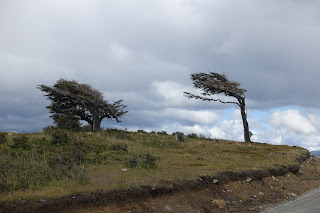This is a lovely photo of ground-dwelling Tierra del Fuego Orchids. There are several kinds that grow there, but we only saw this one. It also shows rotting wood, very unlike our Pacific NW forests with lush nurse logs. Dead wood can hang around for years, rotting very very slowly. The cap of dirt is also very thin, because of the slow rate of decomposition in the cold climate. This was on a 9k hike we did in the Tierra del Fuego National Park, about 10k outside of Ushuaia. We got taken there & picked up by taxi, on a day that multiple cruise boats were coming into port. We figured it was a good day to be in the woods, and it was. Another ?? we first saw in TdF was this: pan de indio. We had no idea what it was, but we saw it everywhere hanging on trees - which it turns out were all Notofagus or Southern Beech. Pan de Indio is an edible fungus and very protein-rich. After we figured out what it was, we ate some (about a week after this). It's spongey and crunchy and pretty flavor-less. It was a staple in the diet of the canoe-dwelling Native Americans before the Europeans came.
The path we took through the park paralleled the Beagle Channel. This was about half-way in, at a lovely stopping spot, where a very nice Argentinan couple took our photo and shared their Mate with us. Mate is a tea made from Hierbamate which is drunk everywhere in Argentina in special cups with straws that strain the tea leaves. It's common to see folks carrying around thermoses full of hot water and mate cups, and they share. In our 6 weeks of travel, someone must have offered us to try their mate at least once a week. Mate with sugar, bitter mate, cold water mate, you name it. Mike, Maeve and I all tried it. It was bitter.
You can see the Beagle Channel and Chile. The other side of the chanel is Chile, and at that latitude, the snow line was at 600 M. These mountains are the tail end of the Andes as they dip into the sea. You can see that we're wearing jackets and caps, even though it's July 11, high summer.
Another day we did a hike up a ski slope towards Glaciar Martial, which you can see behind Maeve. It's a great hike to the glaciar, but we didn't go all the way up, stopping to play on a snow field well below the glaciar, where we also got snowed on a little bit. Another lovely summer day. We also saw skiiers making their way up a snow field to later ski down. This glacier provides Ushuaia with drinking water.
One day, we took a boat trip to Estancia Haberton. This is a view of Ushuaia, with the mountains and glaciars in the background. It had snowed at higher elevations (over 600M) overnight and you can see the snow line. Estancias are plantations, and Haberton was one of the first ones in the Ushuaia area, founded by an English family who had a long history of studying the Canoerers who lived there. The Estancia is no longer active in sheep farming or other agricultural activity, and is run as a museum. The trip out was through the Beagle Chanel to the East, where we saw islands with rock cormerants and this colony of sea lions.
Part of Haberton is an island that's now a private nature preserve with lots of penguins. In our trip, we saw the island from our big catamaran, then took zodiacs from Haberton to beach on the island and walk around. This was AMAZING! There were over 10,000 Magellanic penguins in the colony. They were everywhere on the beach, in their burrows, and their babies were molting into adult swim plumage. There were also 2 Emperor penguins on the island - our guide wasn't sure, because it's only the second year Emperors have been there and it's far north for their range, but it's possible they're checking it out to build a larger colony in the future. They were huge comparted to the little Magellanic penguins. There was also a small colony (about 100) Gentu penguins on the island.
On the bus ride back to Ushuaia, we saw some special Patagonian trees, nicely shaped by the wind, as well as lots of beaver damage. Someone had the great idea to release Canadian beavers in Tierra del Fuego as a commerial venture. It didn't work well, because although it's cold there, it's not as cold as Canada in winter, so the beavers' pelts weren't lush. There were not natural predadors, and now they're a menace. We saw beaver damage in both Chilean and Argentinian Tierra del Fuego, and there are fears they're moving into the mainland.
From Ushaia, we took a boat around Cape Horn to Chile. In the port, we saw this wonderful mural, which is a comment on the Falkland Islands War. Note: Mike thinks this sign is a comment on Francis Drake, when he went pirating along the Beagle Channel. But, there were various other signs about the Falklands. The sign says: "The mooring of English pirate boats is prohibited." Argentinian maps all include both part of Antartica, which Argentina claims and the Islas Malvinas, or Falkland Islands.









No comments:
Post a Comment